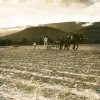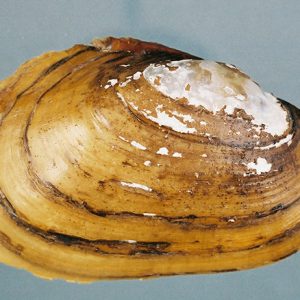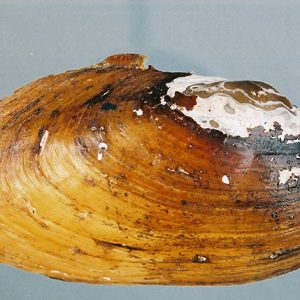calsfoundation@cals.org
Arkansas Fatmucket
aka: Lampsilis powellii
The Arkansas fatmucket is a bivalve mollusk belonging to the family Unionidae, commonly referred to as freshwater mussels, naiads, or clams. Each freshwater mussel is composed to two halves (valves) of a hard outer shell, with the living animal (soft tissues) residing securely inside. The Arkansas fatmucket (Lampsilis powellii) was described as a species new to science in 1852 by Isaac Lea, a naturalist and publisher by trade residing in Philadelphia, Pennsylvania. Lea based his description on specimens provided to him by Dr. Josiah Hale and Professor W. Byrd Powell from the Saline River at Benton (Saline County).
Adults rarely reach a length of four inches (100 millimeters), and males and females are sexually dimorphic—that is, they have slightly different shell shapes. The shell is elliptical to oblong ovate in outline, slightly to moderately inflated, the anterior end rounded, the posterior end somewhat pointed in males but broadly rounded to truncate in females. The individual valves are thin to moderately thick, and the outer surface of the shell (periostracum) is somewhat shiny and yellowish. Color rays are lacking, but lines of tiny pits running down the shell may appear to be rays. The inside of the shell (nacre) is usually white but is sometimes pink to iridescent.
The Arkansas fatmucket is endemic to the Ouachita Mountain area, found in the free-flowing streams of the Ouachita River drainage in western and central Arkansas. It is also known from the Caddo River, upper Ouachita River, and South Fork Ouachita River, as well as the Saline River including the Alum, Middle, North, and South forks. Four microhabitats within rivers are favorable for the Arkansas fatmucket: long pools with cobble and rock as the primary substrate types; backwater areas downstream of peninsulas or islands covered with American water-willow (Justicia americana) with cobble and sand as the dominant substrate; slow-moving pools upstream from Justicia americana islands with sand, gravel, and cobble substrate; and overflow, secondary channel pools, and tributary confluence areas with sand, cobble, and some rock substrate.
The Arkansas fatmucket is not found in lakes or ponds and cannot adapt its life strategies (feeding, reproduction, etc.) to impounded waters. The Arkansas fatmucket was listed as a federally protected threatened species by the U.S. Fish and Wildlife Service in April 1990. The Arkansas Fatmucket Recovery Plan, published by the U.S. Fish and Wildlife Service in 1992, identified impoundments, channel alteration, gravel dredging, sedimentation, and water quality degradation as the major threats to its continued existence.
Freshwater mussels reproduce by males releasing into the water column sperm that are taken up by females during filter feeding and respiration. Females release eggs from the gonads to a chamber within their body where fertilization occurs, and then the thousands of fertilized eggs are moved to the gills (ctenidia) for brooding in the marsupium until they develop into a parasitic larval form. Nearly all freshwater mussels have parasitic larvae that complete development to the juvenile stage while attached to fish.
The larval form found in freshwater mussels like the Arkansas fatmucket is called a glochidium. Glochidia are small bivalves that attach to the fish host by clamping the shell valves on fins or gill filaments, with subsequent encapsulation in a cyst. Most members of the genus Lampsilis have highly developed structures called mantle flaps that are among the best-known features of mussel biology. The mantle flaps mimic a food item of the host fish, such as a minnow in the case of the Arkansas fatmucket, and the movement of the mantle flap entices the fish to strike.
In Lampsilis, the marsupia typically protrude between the shell valves and the mantle flaps during lure display. The attack by the host fish ruptures the marsupia and releases glochidia, which then attach and encyst on the host fish gills. There they reside for a period of up to sixty days before dropping to the stream bottom as a young Arkansas fatmucket. Females have been observed carrying young within the marsupia (termed gravid) from March through October. Spotted bass (Micropterus punctulatus) and largemouth bass (M. salmoides) are the optimal fish hosts, while shadow bass (Ambloplites ariommus), green sunfish (Lepomis cyanellus), longear sunfish (L. megalotis), bluegill (L. macrochirus), and smallmouth bass (M. dolomieu) appear to be marginal hosts with low (less than one percent) juvenile transformation success.
The U.S. Fish and Wildlife Service noted in a five-year status review published in 2013 that extant populations of Arkansas fatmucket occur throughout most of the historic range; however, population declines and reduced distribution have been documented since its listing as a threatened species. Catastrophic population declines have resulted in the extirpation (local extinction) of Arkansas fatmucket from the South Fork Saline River, while the Caddo River, Ouachita River, South Fork Ouachita River, Middle Fork Saline River, and North Fork Saline River populations have experienced substantial declines. Increasingly small and isolated populations are becoming more susceptible to unpredictable events and ongoing and/or increasing anthropogenic (human-caused) impacts. Without immediate efforts to conserve existing habitat, restore historic habitat, and subsequently augment and reintroduce Arkansas fatmucket in areas experiencing population decline or extirpation, this species will likely become extirpated across much of its range in the foreseeable future.
For additional information:
Barnhart, M. C., W. R. Haag, and W. N. Roston. “Adaptations to Host Infection and Larval Parasitism in Unionoida.” Journal of the North American Benthological Society, 27, no. 2 (2008): 370–394.
Gordon, M. E., and J. L. Harris. “Distribution of Lampsilis powelli (Lea) (Bivalvia: Unionacea).” The Nautilus 99, no. 4 (1985):142–144.
Haag, W. R. North American Freshwater Mussels: Natural History, Ecology, and Conservation. Cambridge, UK: Cambridge University Press, 2012.
Harris, J. L., and M. E. Gordon. Arkansas Mussels. Little Rock: Arkansas Game and Fish Commission, 1990.
Harris, J. L., W. R. Posey II, C. L. Davidson, J. L. Farris, S. Rogers Oetker, J. N. Stoeckel, B. G. Crump, M. Scott Barnett, H. C. Martin, M. W. Matthews, J. H. Seagraves, N. J. Wentz, R. Winterringer, C. Osborne, and A. D. Christian. “Unionoida (Mollusca: Margaritiferidae, Unionidae) in Arkansas, Third Status Review.” Journal of the Arkansas Academy of Science 63 (2009): 50–86.
Robison, Henry W., and Robert T. Allen. Only in Arkansas: A Study of the Endemic Plants and Animals of the State. Fayetteville: University of Arkansas Press, 1995.
Scott, Mary. “Life History and Population Biology of the Arkansas Fatmucket, Lampsilis powellii (Lea 1852).” MS thesis, Arkansas State University, 2004.
U.S. Fish and Wildlife Service. “Arkansas Fatmucket, Lampsilis powellii (I. Lea 1852), 5-Year Review: Summary and Evaluation.” Conway, AR: USFWS Ecological Services Field Office, 2013.
John Harris
Scott, Arkansas
 Environment
Environment Fatmucket - Female
Fatmucket - Female  Fatmucket - Male
Fatmucket - Male 



Comments
No comments on this entry yet.